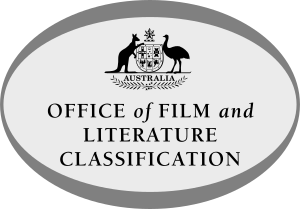Difference between revisions of "Australian Classification Board"
From Retro CDN
PolarManne (talk | contribs) |
|||
| (9 intermediate revisions by 4 users not shown) | |||
| Line 1: | Line 1: | ||
| + | [[File:Australian Classification Board logo.svg|thumb|right|ACB logo.]] | ||
[[File:OFLC new logo.svg|thumb|right|OFLC logo.]] | [[File:OFLC new logo.svg|thumb|right|OFLC logo.]] | ||
[[File:OFLC logo.svg|thumb|right|Old OFLC logo.]] | [[File:OFLC logo.svg|thumb|right|Old OFLC logo.]] | ||
| − | The '''Office of Film and Literature Classification''' is a statutory censorship and classification body which provides day to day administrative support for the Classification Board which classifies films, video games and publications in Australia, and the Classification Review Board which reviews films, computer games and publications when a valid application has been made. | + | The '''Australian Classification Board''' (previously known as the '''Office of Film and Literature Classification''') is a statutory censorship and classification body which provides day to day administrative support for the Classification Board which classifies films, video games and publications in Australia, and the Classification Review Board which reviews films, computer games and publications when a valid application has been made. |
The Classification Board and the Classification Review Board are established by the Classification (Publications, Films and Computer Games) Act 1995 (Cth). This Act also contains the National Classification Code. | The Classification Board and the Classification Review Board are established by the Classification (Publications, Films and Computer Games) Act 1995 (Cth). This Act also contains the National Classification Code. | ||
| Line 13: | Line 14: | ||
Some films and games (e.g. educational content) may be exempt from classification. | Some films and games (e.g. educational content) may be exempt from classification. | ||
| − | {| | + | {| class="wikitable" |
| + | |- | ||
| + | ! Rating | ||
| + | ! Description | ||
|- | |- | ||
|[[File:OFLC small E.svg|90px]] | |[[File:OFLC small E.svg|90px]] | ||
| Line 58: | Line 62: | ||
Films rated X18+ are currently legally available for purchase in only the ACT and the Northern Territory. However these films may be legally purchased from interstate via mail-order. Enforcement is relaxed and most adult shops carry extensive stock of X18+ material. | Films rated X18+ are currently legally available for purchase in only the ACT and the Northern Territory. However these films may be legally purchased from interstate via mail-order. Enforcement is relaxed and most adult shops carry extensive stock of X18+ material. | ||
|- | |- | ||
| − | | | + | |[[File:Australian Classification Refused Classification (RC).svg|90px]] |
|'''Refused Classification (RC)''' | |'''Refused Classification (RC)''' | ||
| Line 70: | Line 74: | ||
Classification is mandatory, and films that are refused classification by the OFLC are banned for sale, hire, public exhibition or importation into Australia, carrying a maximum fine of $275,000 and/or 10 years jail. It is legal to possess Refused Classification material, unless it has been Refused Classification due to illegal content (e.g. child pornography). | Classification is mandatory, and films that are refused classification by the OFLC are banned for sale, hire, public exhibition or importation into Australia, carrying a maximum fine of $275,000 and/or 10 years jail. It is legal to possess Refused Classification material, unless it has been Refused Classification due to illegal content (e.g. child pornography). | ||
| + | |- | ||
| + | |[[File:Australian Classification Check the Classification (CTC).svg|90px]] | ||
| + | |'''Check the Classification (CTC)''' | ||
| + | |||
| + | The content has been assessed and approved for advertising unclassified films and computer games. "This film has advertising approval. Check the classification closer to the released date" is usually written on the marking. | ||
| + | Any advertising of unclassified films and games must display the CTC message on posters, trailers, on the Internet, and any other types of advertising. | ||
| + | Once the content is classified, the classification marking replaces the CTC marking on all advertising material. | ||
|} | |} | ||
| Line 75: | Line 86: | ||
''These ratings are still shown on some older video games that are still on sale in Australia'' | ''These ratings are still shown on some older video games that are still on sale in Australia'' | ||
{| | {| | ||
| − | | [[File: | + | | [[File: OFLC old G.svg|90px|OFLC Rating: G]] || '''G'''- '''General ''': The G classification is for a general audience. |
|- | |- | ||
| − | | [[File: | + | | [[File: OFLC old G8.svg|90px|OFLC Rating: G8+]] || '''G8+'''- '''General for children over 8 years of age''': Material classified G8+ may contain material which some children find confusing or upsetting, and may require the guidance of parents or guardians. It is not recommended for viewing by people under 8 without guidance from parents or guardians. ''This rating has since been changed to PG.'' |
|- | |- | ||
| [[File:OFLC_Australia Rating_-_M15.png|90px|OFLC Rating: M15+]] || '''M15+'''- '''Mature''': Material classified M15+ is not recommended for people under 15 years of age. However, there are no legal restrictions on access. ''This rating has since been changed to M to prevent confusion with the stronger MA15+ classification.'' | | [[File:OFLC_Australia Rating_-_M15.png|90px|OFLC Rating: M15+]] || '''M15+'''- '''Mature''': Material classified M15+ is not recommended for people under 15 years of age. However, there are no legal restrictions on access. ''This rating has since been changed to M to prevent confusion with the stronger MA15+ classification.'' | ||
| Line 94: | Line 105: | ||
[[Category:Game content rating systems]] | [[Category:Game content rating systems]] | ||
| + | [[Category:TV show and movie ratings]] | ||
Latest revision as of 16:42, 24 December 2023
The Australian Classification Board (previously known as the Office of Film and Literature Classification) is a statutory censorship and classification body which provides day to day administrative support for the Classification Board which classifies films, video games and publications in Australia, and the Classification Review Board which reviews films, computer games and publications when a valid application has been made.
The Classification Board and the Classification Review Board are established by the Classification (Publications, Films and Computer Games) Act 1995 (Cth). This Act also contains the National Classification Code.
The Office of Film and Literature Classification has taken 'censorship' out of its title. However, it is able to censor media by refusing classification and making the media illegal for hire, exhibition and importation to Australia. This has attracted particular controversy in the case of computer and video games, as for many years the R18+ classification did not exist for video games, and even today many games are still refused classification.
Notices
Film and video game ratings
As of May 24, 2005, the Movie Ratings system has been color-coded and the presentation updated, following changes in the code. However, the previous classification symbols can still be seen on DVD and video packaging released before the change.
Some films and games (e.g. educational content) may be exempt from classification.
| Rating | Description |
|---|---|

|
E (Exempt from Classification) - These films are granted permission to be sold without a specific classification. This classification is usually granted to (and not limited to) educational content such as documentaries, concerts, fitness programmes, educational software, live TV and non-violent sporting events. Currently there is no predetermined marking for exempt films and computer games [1], although it is advised that films and computer games that are exempt display “This film/computer game is exempt from classification”.
The content varies depending on the show / film. Any film or computer game which is to be rated E must not exceed the PG rating. |

|
G (General) - These films and computer games are for general viewing. However, G does not necessarily designate a children’s film or game as many of these productions contain content that would be of no interest to children.
The content is very mild in impact. |

|
PG (Parental guidance recommended) - These films and computer games contain material that may confuse or upset younger viewers.
The content is mild in impact. |

|
M (Recommended for mature audiences) - These films and computer games contain material that requires a mature perspective. This classification was formerly known as M15+. There is no restriction on access.
The content is moderate in impact. Note that the classifications above this point are advisory in nature only—they are not legally binding. By contrast, the classifications below are legally restricted—i.e., it is illegal to sell or exhibit materials so classified to a person younger than the respective age limit. |

|
MA15+ (Not suitable for under 15s) - The content is considered unsuitable for exhibition by persons under the age of 15. Persons under 15 may only legally purchase or exhibit MA15+ rated content under the supervision of an adult guardian. This is a legally restricted category.
People under 15 are not permitted to purchase or rent films or video games classified MA15+ unless they are accompanied by a parent or adult guardian. The content is strong in impact. |

|
R18+ (Restricted) - People under 18 may not buy, rent or exhibit these films and computer games.
There are five classification categories for video games: G, PG, M, MA15+, R18+. Video games which exceed the impact of what the R18+ rating allows are refused classification (RC). Games refused classification may be edited and resubmitted by their developers to garner an R18+ classification. The content is high in impact. |

|
X18+ (Restricted) - People under 18 may not exhibit, buy or rent films that have been issued this classification. The X18+ rating applies to film only—any video games which rate higher than MA15+ are Refused Classification.
This rating applies to sexual content. Films rated X18+ are currently legally available for purchase in only the ACT and the Northern Territory. However these films may be legally purchased from interstate via mail-order. Enforcement is relaxed and most adult shops carry extensive stock of X18+ material. |

|
Refused Classification (RC)
Films which are very high in impact and/or contain any type of violence in conjunction with real sexual intercourse are Refused Classification by the OFLC. The reasons why a film may be refused classification that:
Classification is mandatory, and films that are refused classification by the OFLC are banned for sale, hire, public exhibition or importation into Australia, carrying a maximum fine of $275,000 and/or 10 years jail. It is legal to possess Refused Classification material, unless it has been Refused Classification due to illegal content (e.g. child pornography). |

|
Check the Classification (CTC)
The content has been assessed and approved for advertising unclassified films and computer games. "This film has advertising approval. Check the classification closer to the released date" is usually written on the marking. Any advertising of unclassified films and games must display the CTC message on posters, trailers, on the Internet, and any other types of advertising. Once the content is classified, the classification marking replaces the CTC marking on all advertising material. |
Previous video game ratings
These ratings are still shown on some older video games that are still on sale in Australia
See also
- Brazil - Department of Justice, Rating, Titles and Qualification
- Europe (excluding Germany) - Pan European Game Information
- Germany - Voluntary Monitoring Organisation of Entertainment Software
- Japan - Computer Entertainment Rating Organization
- Korea - Game Rating Board
- United Kingdom - British Board of Film Classification
- United States - Entertainment Software Rating Board






